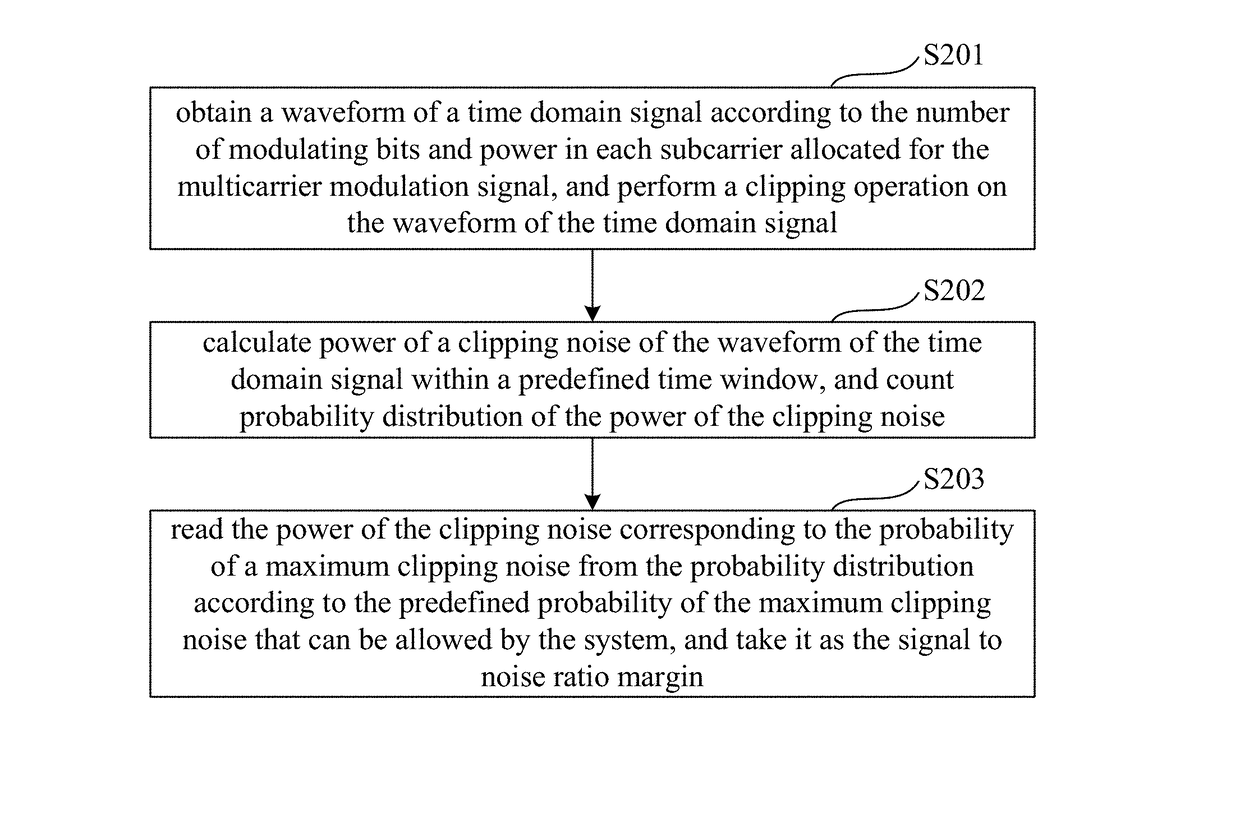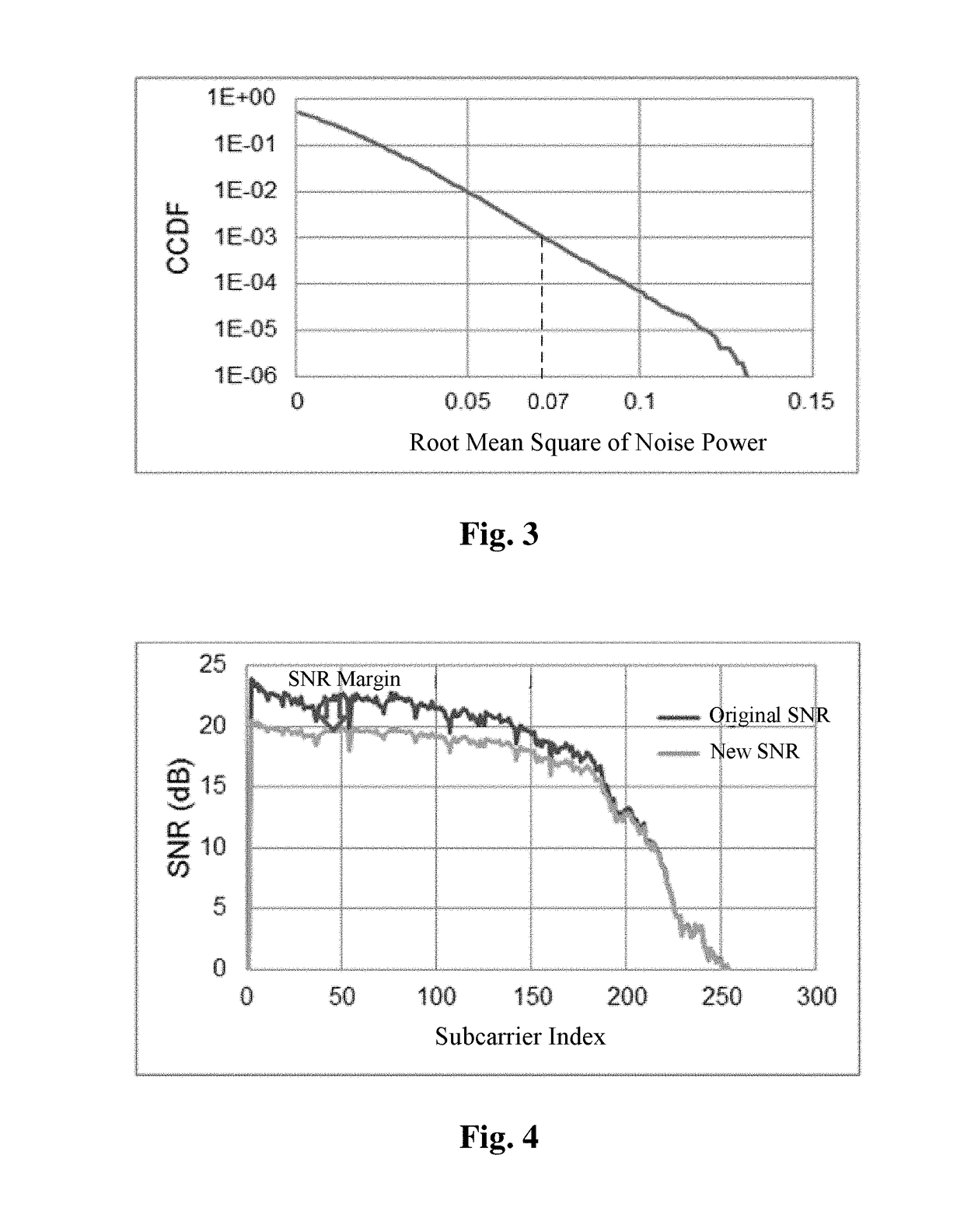Bit allocation method and apparatus for multicarrier modulation signal, and system
a multi-carrier modulation and allocation method technology, applied in the field of communication, can solve the problems of introducing signal distortion, affecting the performance and high peak to average power ratio (papr), so as to reduce the burst errors of multi-carrier modulation signals
- Summary
- Abstract
- Description
- Claims
- Application Information
AI Technical Summary
Benefits of technology
Problems solved by technology
Method used
Image
Examples
embodiment 1
[0035]An embodiment of this application provides a bit allocation method of a multicarrier modulation signal. FIG. 1 is a flowchart of the method. Referring to FIG. 1, the method includes:
[0036]step 101: determining a signal to noise ratio margin according to a predefined probability of a maximum clipping noise that can be allowed by the system; and
[0037]step 102: allocating the number of modulating bits and power in each subcarrier for a multicarrier modulation signal according to the signal to noise ratio margin.
[0038]In step 101, the predefined probability of a maximum clipping noise that can be allowed by the system refers to a probability of occurrence to which a maximum clipping noise (clipping distortion) that can be allowed by the system to occur corresponds. A value of such a probability may be predefined; however, this embodiment is not limited thereto.
[0039]In an implementation, step 101 may be carried by using the method shown in FIG. 2. As shown in FIG. 2, the method in...
embodiment 2
[0058]An embodiment of the present disclosure further provides a bit allocation apparatus of a multicarrier modulation signal. As principles of the apparatus for solving problems is similar to that of the method according to Embodiment 1, the implementation of the method according to Embodiment 1 may be referred to for implementation of the apparatus, with identical contents being not going to be described herein any further.
[0059]FIG. 6 is a schematic diagram of a structure of the bit allocation apparatus of a multicarrier modulation signal according to this embodiment. Referring to FIG. 6, the apparatus 600 includes: a determining unit 601 and an allocating unit 602. In this embodiment, the determining unit 601 is configured to determine a signal to noise ratio margin according to a predefined probability of a maximum clipping noise that can be allowed by the system, and the allocating unit 602 is configured to allocate the number of modulating bits and power in each subcarrier fo...
embodiment 3
[0068]An embodiment of the present disclosure further provides a transmitter, such as a base station in a multicarrier communication system, the transmitter including the bit allocation apparatus of a multicarrier modulation signal according to Embodiment 2.
[0069]FIG. 9 is a schematic diagram of a structure of the transmitter of this embodiment. As shown in FIG. 9, the transmitter 900 may include a central processing unit (CPU) 901 and a memory 902, the memory 902 being coupled to the central processing unit 901. The memory 902 may store various data, and furthermore, store programs for information processing, and execute the programs under control of the central processing unit 901.
[0070]In an implementation, the functions of the bit allocation apparatus according to Embodiment 2 may be integrated into the central processing unit 901. In this implementation, the central processing unit 901 may be configured to determine a signal to noise ratio margin according to a predefined proba...
PUM
 Login to View More
Login to View More Abstract
Description
Claims
Application Information
 Login to View More
Login to View More - R&D
- Intellectual Property
- Life Sciences
- Materials
- Tech Scout
- Unparalleled Data Quality
- Higher Quality Content
- 60% Fewer Hallucinations
Browse by: Latest US Patents, China's latest patents, Technical Efficacy Thesaurus, Application Domain, Technology Topic, Popular Technical Reports.
© 2025 PatSnap. All rights reserved.Legal|Privacy policy|Modern Slavery Act Transparency Statement|Sitemap|About US| Contact US: help@patsnap.com



